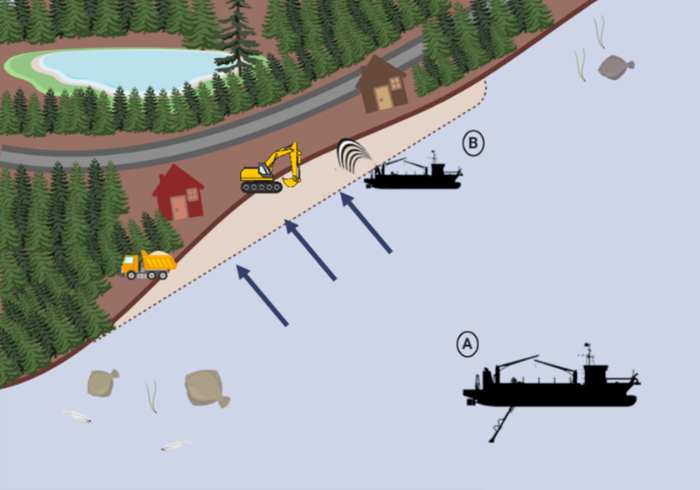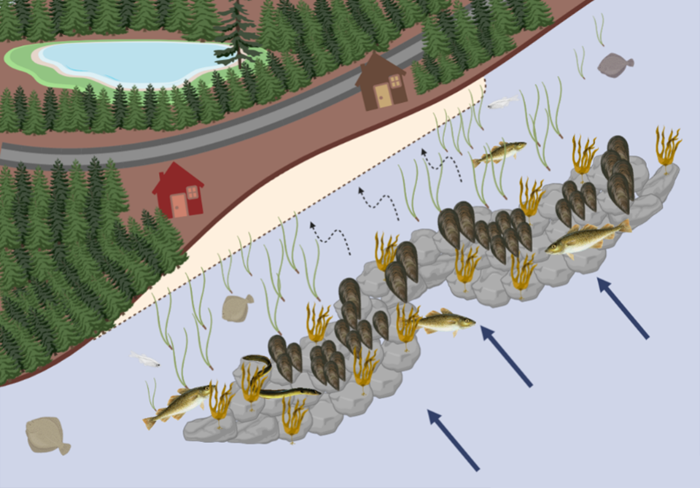How can we combine coastal protection with greater biodiversity? A new DTU project aims to investigate this topic.
When Denmark’s thousands of kilometres of coastline are hit by severe storms, it can have major consequences. Storms, waves, and strong sea currents wash sand away and eat into the shoreline. Erosion can remove sandy beaches and destroy coastlines. This is bad for landowners, beachgoers, and lots of other people who enjoy the Danish beaches.
After damage has occurred, beach replenishment is often carried out to restore the beach. Beach replenishment involves drawing sand up from the seabed in deeper water and placing it at the shore in shallow water to re-establish the beach.
The aim is to restore the coastline and protect the shore from future erosion. However, the method often only preserves the coastline for a few years. Beach replenishment is also problematic in the long run, because marine life is often adversely affected – both in the deep water where the sand is extracted and in the shallow water where the sand is placed.
First project of its kind in Denmark
The question therefore arises: Is there another more enduring and sustainable approach to coastal protection that also promotes biodiversity and marine life?
DTU’s new stone reef and coastal protection project, BARREEF, which is funded by the Velux Foundation and the Swedish energy company Vattenfall, will examine this.
"The BARREEF project is innovative, and nothing like it has been tested in Denmark on this scale. We want to document the positive effects of building a stone reef, that provides coastal protection and also supports marine life. The hope is to develop a method of coastal protection that can reduce the need for beach replenishment," says Jon C. Svendsen, Senior Researcher at DTU Aqua.
In addition to DTU Aqua and DTU Mechanical Engineering, the project involves of a number of partners: Local Government Denmark (KL), Havnatur, and Aalborg University.
Reef protects against waves
Studies abroad suggest that nature-based solutions can contribute to coastal protection. Coral reefs, seagrasses, and mangroves can reduce the risk of coastal erosion. Denmark does not have the coral reefs or mangroves that exist in tropical countries, but Denmark does have stone reefs that get overgrown with seaweed, mussels, etc. Such stone reefs are likely to have coastal protection effects, if they are positioned and designed correctly.
The plan is to place the stone reef some distance from the shore, where it will break up the waves. This absorbs part of the waves’ energy before they reach the shore.
An earlier stone reef project by DTU Aqua from 2016-2020 showed good results in relation to marine life. For example, at Bredgrund near Sønderborg, around 100 times more Atlantic cod were observed in the area compared to two years earlier, before the stone reef was established. At Læsø island, where the Danish Nature Agency built a stone reef in 2008, more saithe and larger cod were observed after the event. Studies also found more harbor porpoises in the area.
DTU Aqua’s earlier projects focused only on fish and biodiversity, not coastal protection. The new BARREEF project combines the two elements.
Nature contributes
DKK 2 million has been budgeted for granite from Norway, corresponding to approx. 4,000 cubic metres.
Once the rocks have been positioned at sea, scientists expect the new reef to serve several functions. Researchers will investigate whether sand, which becomes deposited on the inner side of the reef, can help protect the beach, because the stone reef prevents the waves from reaching the shore with the same force. The reef will thereby also protect the sand, leading to other benefits for flora and fauna.
Eelgrass contributes to marine vegetation and provides important habitats for fish such as cod and eels, as well as many small marine organisms (e.g. invertebrates). Eelgrass does well on a stable sandy bottom, and the BARREEF project will help provide this, because the stone reef is expected to limit the waves. Without the reef, the waves can wash away the sand, but after the stone reef is established, the eelgrass will have better growing conditions. Eelgrass is important, as when it grows densely and spreads in a stable area, it binds CO2, which helps combat climate change. Sand can also become deposited between the plants, slowly raising the seabed.
Mussels and seaweed prefer to live on hard surfaces. When these species grow on the reef, it also helps to reduce the force of the waves as they come rolling in.
The project is thus expected to gather important knowledge about restoring nature, both in terms of flora and fauna. The stone reef is expected to help maintain biodiversity, as it will create new habitats found only on reefs. This has a number of beneficial effects, providing hiding places and sources of food for fish, and has the potential to support larger cod stocks.
Location not yet known
As part of the project, researchers will investigate the best position for the stone reef, and DTU Aqua is working with DTU Mechanical Engineering to this end. The department will develop models to show which coastlines have the greatest potential. The models will estimate how the coastline will react when tonnes of rocks are positioned in the sea.
"Our own studies and enquiries from local actors will help us determine which coasts will be most suitable and where a stone reef can have the most beneficial effect. We will ultimately select one site, and it’s very important that the project has local support from the beginning," says Jon C. Svendsen. He expects the stone reef to be completed in two years, and to then be monitored by researchers in the years that follow.
A tool to prevent erosion
Where does Jon C. Svendsen expect the project to be in five years?
"It is our hope that the study will have shown an increase in fish abundance and biodiversity, and that the reef has contributed to coastal protection. If so, the reef will have benefited marine life and helped to restore the beaches. Hopefully, there will be no erosion of the coast in the reef’s immediate vicinity, and the beach will have become protected, with more sand on the inner side of the reef. This increases coastal protection. At the same time, I expect the reef to be quickly colonized by seaweed, marine invertebrates (e.g. mussels), and many fish, and that we will see a general increase in biodiversity in the local area."
If the BARREEF project has the expected effects, it could be copied in other similar coastal areas in Denmark. However, the method is not expected to be suitable for all coastlines. The method will hopefully serve as an additional tool when considering how to address the problem of erosion on Danish coasts in the future.

Beach replenishment. The arrows illustrate waves hitting the shore unimpeded, which can result in the beach being washed away. After the wave action has eaten into the shore, beach replenishment is often carried out to restore the beach. Beach replenishment involves drawing sand up in deep water (A), and then placing it at the beach (B). Beach replenishment negatively impacts marine life—both where the sand is drawn from and where it is laid. Beach replenishment also often lasts only a few years because the waves continue to wash away the sand. Figure: Tim Wilms.

Principle of the BARREEF project. The new DTU BARREEF project will investigate whether stone reefs can be used to both protect the coast and promote marine life. The figure shows the waves using arrows. In addition to limiting the damage to the beach, the stone reef aims to provide habitats for seaweed, marine invertebrates (e.g. mussels) and fish, and to promote the growth of eelgrass on the inner side of the reef. More sand is expected to be deposited on the inner side of the reef as conditions become more stable, which will presumably reduce the need for beach replenishment. Figure: Tim Wilms.
Video on restauration of cobble reefs in general (not the BARREEF project)